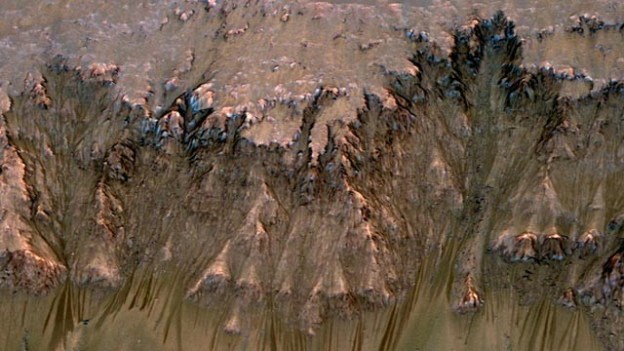
Researchers have uncovered new evidence that water is flowing just below the surface of Mars, according to a new study published in the journal Science. The discovery was made after images taken by a NASA probe revealed brown streaks (pictured above) on the Red Planet’s surface, which could have been caused by moving salt water.
While the study is not conclusive, scientists say the finding corroborates evidence found by other probes. Unlike past discoveries, however, the water revealed in this study is actually flowing today, unlike other studies that found evidence of water that may have existed on the cold, arid planet a millennium ago.
The discovery was made by a team from the University of Arizona in Tuscon, led by planetary scientist Alfred McEwen. The team analyzed images taken by the Mars Reconnaissance Orbiter, which has been circling the planet since 2006. Each year, the MRO records images of the Martian surface, in both summer and winter periods. The telltale brown streaks appeared in images taken during the warmer spring and summer months, but disappeared when temperatures dropped.
“The best explanation for these observations so far is the flow of briny water,” said McEwen. This water could have disturbed the dusty grown above, causing the streaks to form.
Unlike fresh water, salty water can remain liquid at temperatures far below water’s usual freezing point. When the streaks were recorded, the temperature on Mars was between -20 and -30 degrees Celsius.
If water does indeed exist below Mars’ surface, it increases the probability that alien life exists on the planet. Still, the chances of living creatures or plants being able to survive in water with the high levels of salt required to keep the water in liquid form at such low temperatures remain uncertainly low.
Scientists have discovered possible evidence of water on Mars at least twice before. In 2004, the Mars rover Opportunity found chemical compounds that scientists say likely formed because of standing water that had long since evaporated; and in 2008, NASA’s Phoenix probe landed near the north pole of Mars, and took pictures of strange blobs on its legs, which some believe was briny ice.
So while it remains uncertain whether water actually exists on Mars, McEwen’s discovery has bolstered hopes in the scientific community that a conclusive discovery is tangible.
“NASA’s Mars Exploration Program keeps bringing us closer to determining whether the Red Planet could harbor life in some form,” sad NASA Administrator Charles Bolden in a statement made today, “and it reaffirms Mars as an important future destination for human exploration.”


